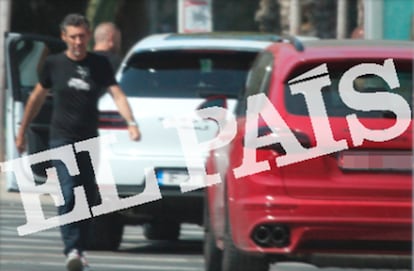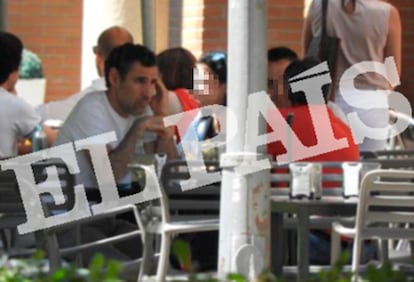How a network of octogenarians wound up helping a Spanish drug gang launder its cash
An attorney in Madrid used a group of seniors living in poverty to conceal the income from traffickers who had imported four tons of cocaine into Spain

Genaro M., an 84-year-old from Madrid, enjoys a luxury lifestyle – on paper at least. He holds 44 bank accounts and is on the paperwork for a total of 25 companies. One of them, Lacy Patrimonio SL, a real estate company that he owns, has share capital of €3.5 million, and controls 28 properties, parking spaces and a commercial premise in General Lacy street in Madrid, according to the firm’s latest accounts. But since 2008, this octogenarian has resided in an assisted living facility run by Madrid City Hall, and receives €286 a month in benefits destined for people who have no resources.
Genaro M. is allegedly one of the six frontmen used by Juan Ramón García Crespo, an attorney from Madrid who has been under investigation since 2019 as part of so-called “Operation Beautiful.” He was under the microscope of the authorities for laundering money from the biggest drug-trafficking network ever busted in Spain’s eastern Valencia region. According to court papers from the case, which is being investigated by Spain’s High Court, the Audiencia Nacional, the network was run remotely from Alicante by alleged trafficker Juan Andrés Cabeza and moved four metric tons of cocaine. EL PAÍS has had access to these documents.
García Crespo is alleged to have made use of six octogenarians living in poverty – one of whom has since died – to legalize the network’s flow of income. The seniors thought to have been used by the lawyer – who is not currently in custody, and is facing charges of money laundering and belonging to a criminal organization – were on the books of 387 companies, which in turn owned 414 properties in Madrid. The fictitious scheme also involved a web of nearly 300 bank accounts.
Eugenio C., 89, was part of the attorney’s money-laundering scheme. Despite having an income of less than €8,100 a year from his pension, he controlled a total of 264 firms and 135 properties on paper in the year 2017. And today, like the rest of the seniors who signed up to the scheme, he is also facing charges of money laundering and belonging to a criminal organization. “I haven’t seen that man for a long time,” he told EL PAÍS via phone. “All of that is over. Period. Goodbye.” He stands accused of laundering €120,000.

José Luis G., who is also in his eighties, is accused of laundering €314,000. He admits that the lawyer paid them for providing their signature at a notary’s office, but he stops the conversation dead when asked for more details. “I’d rather not talk,” he said. “Goodbye.” Genaro M., 84, showed a similar attitude. “I’m going to talk to García Crespo before answering your questions,” he told EL PAÍS, speaking from a municipal care home in the central district of Madrid.
The man in his eighties involved in the network and who has since died was at one time controlling 32 properties, 13 luxury vehicles and two boats with a value of more than €500,000. He was linked to a company called Sail Rent S. L., a car-rental firm with assets of €2.4 million that was allegedly used by García Crespo to legalize the funds from the Cabeza drug gang. The now-deceased frontman is thought to have laundered €756,140 for the organization.
Via another company, real estate firm Volga&Volga, the lawyer used an 80-year-old frontman to control the Lady Lu, a vessel moored in the Alicante port of Denia, and which really belonged to the drug trafficker, who rented it out for €3,500 a day, according to the investigation. The probe found that the ship was valued at €500,000.
The investigation into the case suggests that the attorney always used the same notaries and addresses for his web of frontmen, and they were always granted powers. According to one of the seniors, speaking to investigators, the frontmen would be paid €100 each time that they signed a document in a notary or bank.
García Crespo, who is 65, enjoyed a lifestyle that was in stark contrast with his official income, according to the investigation. Despite living in a large property in the affluent Madrid district of La Moraleja, and driving a Porsche Cayenne and a Ferrari F430, the attorney did not declare any work income, economic activity or wealth tax between 2011 and 2014. Nor were there any payslips or rental income, according to a probe dubbed “Operation Confidence,” a case against García Crespo in which he was accused in 2018 of laundering €3.7 million, and which was eventually shelved. “There is no evidence of a legal source of income declared,” the investigators concluded.
The attorney currently controls 16 properties, among them homes and offices, including his house in La Moraleja, 14 more properties in Madrid and a plot of land in La Manga del Mar Menor, in Murcia. He is also linked to 53 bank accounts.
Investigators are accusing the lawyer of having laundered more than €2 million from the Cabeza drug network.
García Crespo was arrested in September 2019 in his home in La Moraleja, where he had €40,800 in cash stuffed in blue envelopes in a safe. Officers also found four luxury cars.
“Crespo is the main brains of the money-laundering operations of the criminal network being investigated,” states the police report that prompted the arrest of this attorney, who did not respond to questions from EL PAÍS.
An international network with 135 suspects
“Operation Beautiful,” which ensnared lawyer Juan Ramón García Crespo and alleged drug trafficker Juan Andrés Cabeza in 2019, has accumulated 135 official suspects. The network is suspected of importing cocaine from South America into Europe, making use of codewords and encrypted cellphones in a bid to evade detection.
With contacts in Colombia, Portugal, Sweden and Romania, the well-oiled machine run by Cabeza was a hierarchical organization. The criminal enterprise of the drug dealer, who was found to have €1.5 million in cash stored at his home in shoe boxes, included a branch that was dedicated to stealing drugs from other traffickers, threats, extorsion, score-settling, kidnapping and murders.
One of the members of the trafficker’s gang could not be arrested in September 2019 when the network was busted: he was gunned down a week before at the Villa Marco de El Campello shopping mall in Alicante.
Tu suscripción se está usando en otro dispositivo
¿Quieres añadir otro usuario a tu suscripción?
Si continúas leyendo en este dispositivo, no se podrá leer en el otro.
FlechaTu suscripción se está usando en otro dispositivo y solo puedes acceder a EL PAÍS desde un dispositivo a la vez.
Si quieres compartir tu cuenta, cambia tu suscripción a la modalidad Premium, así podrás añadir otro usuario. Cada uno accederá con su propia cuenta de email, lo que os permitirá personalizar vuestra experiencia en EL PAÍS.
¿Tienes una suscripción de empresa? Accede aquí para contratar más cuentas.
En el caso de no saber quién está usando tu cuenta, te recomendamos cambiar tu contraseña aquí.
Si decides continuar compartiendo tu cuenta, este mensaje se mostrará en tu dispositivo y en el de la otra persona que está usando tu cuenta de forma indefinida, afectando a tu experiencia de lectura. Puedes consultar aquí los términos y condiciones de la suscripción digital.
More information
Últimas noticias
The new victims of the Republican war on Obamacare: Millions hit by soaring health insurance premiums
A country divided on migrant rights: Some US states expand protections while others restrict them
Venezuela authorizes the release of another 87 political prisoners
There is as much life left to discover on planet Earth as that which is already known
Most viewed
- David King, chemist: ‘There are scientists studying how to cool the planet; nobody should stop these experiments from happening’
- Reinhard Genzel, Nobel laureate in physics: ‘One-minute videos will never give you the truth’
- Oona Chaplin: ‘I told James Cameron that I was living in a treehouse and starting a permaculture project with a friend’
- Sinaloa Cartel war is taking its toll on Los Chapitos
- The Interoceanic Train, the Mexican alternative to the Panama Canal










































